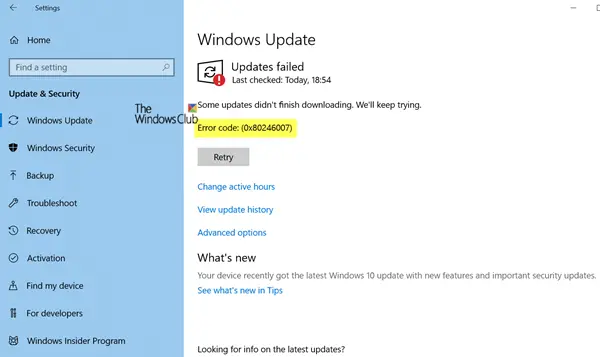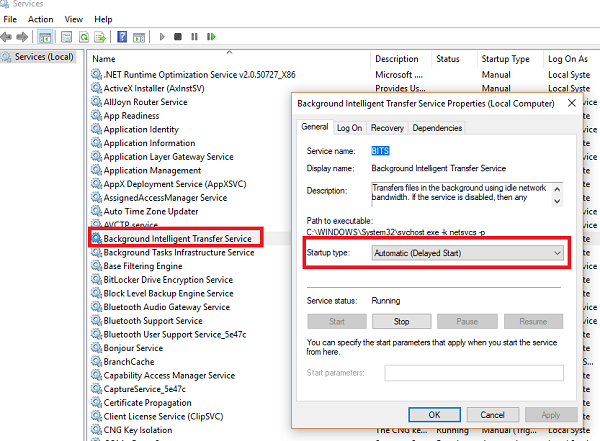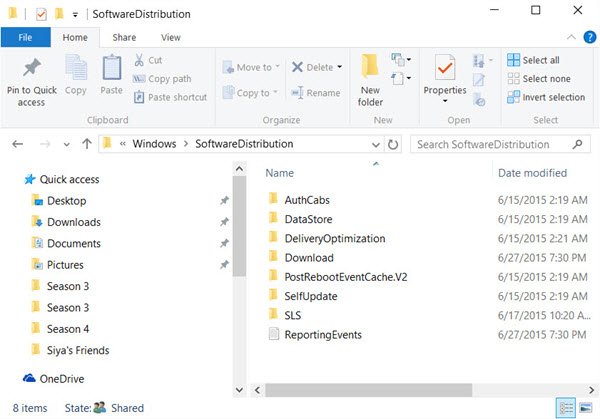When Windows Update service scans for an update and starts downloading, you may receive an error saying Some updates did not finish downloading, We will keep trying, Error code 0x80246007. This may happen with any Windows Update, in fact with Windows applications like OneNote as well. This error happens for many reasons including-
- Windows Update database is corrupt.
- When another process conflicts with the Windows Update component.
- Even when there is an issue with the BITS services.
In this post, we are sharing how you can fix error 0x80246007 when downloading Windows 10 Updates.

Some updates did not finish downloading, Error 0x80246007
Before you begin, you might want to Run this inbuilt Windows Update troubleshooter and see if that helps you.
1] Delete the contents of the Temporary folder
Using the ‘ Run ‘ command, you can delete all the downloaded, failed, and pending Windows Updates.
Open the ‘Run’ dialog box by pressing Win+R in combination, and in the dialog box that opens, type %temp% and hit Enter. In the folder that opens before you select all the files and folders within the Temp folder and then delete them.
%temp% is one of many environment variables in Windows that can open the folder designated by Windows as your Temporary folder, typically located at C:\Users\[username]\AppData\Local\Temp.
2] Restart BITS Service
BITS, or Background Intelligent Transfer Service, is a part of the Windows Update service that manages the background download of Windows Update, scanning for new updates, and so on. If your Windows Update fails multiple times, you may want to restart the BITS service. You will need admin privileges to complete this.

Launch Services console by typing services.msc in the run prompt followed by the enter key.
Search for Background Intelligent Transfer Service. Double-click to open Properties.
In the Properties pane, set the Startup type to Manual and then click on the Start button. If that doesn’t help, set it to Automatic (Delayed) and then restart your computer.
3] Delete Files from Software Distribution Folder

When Windows downloads updates, they are kept in a dedicated folder called Software Distribution. Files downloaded here are automatically deleted once the installation is complete. However, if the installation doesn’t clean up or if it is still pending, you have two choices. First, delete all the files in the SoftwareDistribution folder after pausing Windows Update Service. Second, try restarting the computer multiple times to see if the update process automatically starts.
4] Reset the catroot2 folder
Resetting the catroot2 folder has been known to fix several Windows Update problems.
Catroot and catroot2 are Windows operating system folders that are required for the Windows Update process. When you run Windows Update, the catroot2 folder stores the signatures of the Windows Update package and helps in its installation. The Cryptographic service makes use of the %windir%\System32\catroot2\edb.log file for the updating process. The updates are stored in the SoftwareDistribution folder which are then used by Automatic Updates to carry out the updating process.
Please do not delete or rename the Catroot folder. The Catroot2 folder is automatically recreated by Windows, but the Catroot folder is not recreated if the Catroot folder is renamed.
5] Remove pending.xml file

Navigate to C:\Windows\WinSxS\ folder, search for a pending.xml file and rename it. You may even delete it. This will allow Windows Update to delete pending tasks and build a fresh new update check. See if this helps.
Related: Windows Upgrade errors 8007002C, 80246007, 80070004, 80240020.
I hope something helps! Let us know which worked for you.
Why Windows Update failed to install 0x80246017?
Windows Update error 0x80246017 occurs when the user lacks sufficient privileges to download updates. To resolve this issue, ensure the user has Local Administrator rights. Adjusting user permissions can also help successfully install the updates.
Why Windows Update failed to install 0x8024000b?
The Windows Update error 0x8024000b typically occurs due to issues with update components or corrupt system files. Resolving this error may involve running the Windows Update Troubleshooter or using the System File Checker (SFC) to repair damaged system files.
Leave a Reply